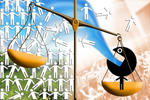
Klipot (Heb. Shells) n.
1. Desires of a spiritual nature that want to rejoice selfishly in the Creator.
Rav Michael Laitman, PhD in the article “Selected Topics in Kabbalah.”
2. Uncorrected desires. Impure desires. Low, animal lusts.
Rav Michael Laitman, PhD in the interview “Heaven and Hell.”
3. Shinui Tzura (difference of form) separates and departs spirituals (see the definition for What is Separation?). Know that this Hofchiut Tzura (opposition of form) from one end to the other separates and drives them to the opposite ends until there isn’t any suction between them.
You already know that there is only a will to bestow in the Ohr Elyon (Upper Light), and not to receive even a bit. The Klipot are of completely opposite Tzura (form), meaning want only to receive and swallow everything; they haven’t any will to bestow whatsoever. For that reason they are separated from the Life of Lives and are therefore called “Dead” and so is anything that cleaves to them.
Baal HaSulam, in Talmud Eser Sefirot, Part 3: Table of Questions and Answers for the Meaning of the Words.
Click Here to Sign Up for a Free Kabbalah Introductory Course – Starts Soon!




